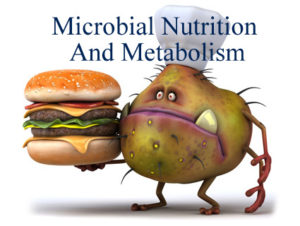Microbial Nutrition and Metabolism
All living organisms require nutrients from the environment for the synthesis of their cell materials and for the generation of energy. Micro-organisms are extraordinarily diverse in their specific physiological properties and correspondingly differ in their specific nutrient requirements as well as their adaptation to the physical conditions in which they live.
Micro-organisms must have a supply of nutrients from the environment for proper growth. Water account for about 80-90% of the total weight of microbial cells and is therefore the major essential requirement in quantitative terms. Water act as solvent for nutrients and carries them across the cytoplasmic membrane in a hydrated form. Because of the polar nature and capacity to bind other polar molecules, water also influences the shape and architecture of many biological polymers especially proteins.
The nutritional requirement of Micro-organisms is of two types :
- Macro elements or macro nutrients
- Micro elements or micro nutrients
- Macro nutrients
Macro nutrients are required by microorganisms in relatively large amounts. These include Hydrogen, oxygen, carbon, nitrogen, phosphorus, sulphur , potassium, calcium, magnesium, and iron.
- Carbon
All photosynthetic (autotrophic) microorganisms for example cyanobacteria that obtain energy from oxidation of inorganic compounds typically use the most oxidized form of carbon, C02 as the principal source of cellular carbon. Therefore many other microorganisms (heterotrophic) cannot use CO2 and instead depend upon the naturally occurring complex organic compounds present in the biosphere for a supply of carbon.
- Oxygen
All microorganism require elemental oxygen to build their biochemical components. Based on their oxygen requirement microorganisms are of 3 types
- Obligatory aerobic
They are dependent on aerobic respiration for their metabolic energy.
2. Obligatory anaerobic
Molecular oxygen is toxic to these as it either kills them or inhibits their growth.
3. Facultative anaerobes
They are able to grow either in the presence or absence of molecular oxygen.
- Nitrogen
Microorganisms require nitrogen for synthesis of cell components like amino acids, purines, pyrimidines, some carbohydrates , lipids, enzyme co- factors and other substance. A number of eubacteria and archaeobacteria have the ability to use atmospheric nitrogen a process called nitrogen fixation. Some feed on inorganic nitrogen compounds such as nitrates, nitrites or ammonium and some derive nitrogen from organic compounds such as amino acids.
- Hydrogen
Hydrogen plays a number of roles in the life of a microbe. It is a structural atom in organic molecules and is a participant in the complex process of energy generation. In the cell membrane of most of the microorganisms proton are involved in the production of ATP via ATP synthase system.
- Sulphur
It is needed for synthesis of certain amino acids (cysteine, cystine and methionine), carbohydrates and B- vitamins (biotin and thiamine). Some organisms require organic sulphur compounds some are capable of utilizing inorganic sulphur compounds and some can even use elemental sulphur.
- Phosphorus
Phosphorus usually supplied in the form of phosphate, is an essential component of nucleic acids, phospholipids, nucleotides like ATP several cofactors, some proteins and other cell components. Almost all microorganisms use free inorganic phosphate containing organic compounds as a source and incorporate directly.
- Potassium
Potassium maintains turgor* pressure and is utilized in a number of enzymatic reactions as a cofactor and especially in protein synthesis.
- Magnesium
It serves as a cofactor for many enzymes and stabilises ribosomes and cell membranes.
- Iron
It is a part of cytochromes and cofactor for enzymes and electron carrying proteins.
- Calcium
It contributes to the heat resistance of bacterial endospores and few other functions. 15% of spore contains dipicolinic acid and calcium.
K, Ca, Mg and Fe are required in milligram quantities and are thus called as minor elements or minor nutrients.These elements exist in the cell as cations and play a variety of roles.


